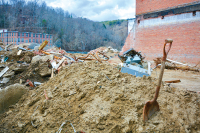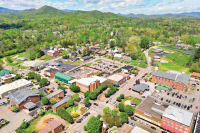WCU braces for housing crunch in face of growth, construction delays
Come the start of fall semester, some Western Carolina University freshmen could find themselves residing in unusual living quarters.
A delay in the construction of a new residence hall is forcing WCU staff to scramble for places to put incoming students — and solutions range from creative to cramped.
Balsam Hall, which will house 426 students, including members of the university’s honors program, was supposed to be completed Aug. 1 after a year-and-a-half construction process. But on Aug. 21 — freshman move-in day — just 236 beds will be ready for students, putting about 200 freshmen in a bit of a bind.
“I haven’t yet given up hope it’s going to make it on time, but we have to look at what’s most likely,” said Keith Corzine, director of residential living for the university.
The construction of Balsam Hall is the first phase of a two-phase $50 million project, which will also include the construction of the similar-sized Blue Ridge Residence Hall. The buildings will be the most state-of-the-art dormitories on campus, featuring bathrooms shared by just two students, study spaces, public kitchens and lobbies.
“From the quality of life perspective, it’s a huge gain,” Corzine said.
Related Items
But the very likely scenario is that phase one of the project, Balsam Hall, won’t be finished on time. Corzine attributes the hold up to a number of construction factors, including delays at critical times and unforeseen challenges with structural work. May was one of the wettest months on record in recent years, Corzine said, which didn’t help things.
“I think we worked through a variety of issues,” he said.
That means making other arrangements for students, hopefully temporarily.
“We think there’s a really strong possibility that anybody inconvenienced by not being able to get in on time would be able to get in around Labor Day, so any inconvenience would be limited to a matter of a couple of weeks,” Corzine said.
Corzine said the university hasn’t decided just where it will house students. One option is Madison Hall, typically used to house graduate students and conference attendees. Grad students could be relocated within the building, Corzine said, and single rooms normally used for conference-goers could be doubled up to house more than one student. Reconfiguring Madison Hall would gain about 70 extra beds, he said.
To find more space, the university will have to get creative. That could likely mean converting study rooms into bedrooms, which the university has done in the past, or temporarily putting two or even three students in single rooms. Corzine realizes, however, that such cramped conditions can be particularly overwhelming for freshman already trying to adjust to life away from home.
“I prefer not to triple it if I can help it,” he said. “You’re going to be putting people in situations with roommates that they most likely don’t know.”
Corzine says he wants to make clear “that the spaces we would put people in would be adequate and as comfortable as we could make them.”
The university will likely cut a financial break to students housed in temporary locations.
“We’ll certainly be looking at the possibility of crediting those students who have been truly inconvenienced, more than likely a pro-rated amount of their housing costs,” said Corzine.
Finishing Balsam Hall by Labor Day will rely on a smooth flow of construction from here on out.
“If everything in the last month-and-a-half breaks just right, if they make up time, and we don’t have any additional delays, then we’re going to be really close with delivering most all the building,” said Corzine. “If you get a delay here or there on something, it’s going to certainly compromise our ability to finish on time.”
Growing pains
The university has confronted a student shuffle before. Just last year, the 400-bed Leatherwood Residence Hall was torn down to make way for Balsam Hall and another residence hall that will be built beside it. Students lived in Leatherwood for half the year, then were relocated to empty rooms for the second semester.
“We were able to absorb them mid-year somewhere else,” said Corzine. “That hit us at a point where on-campus demand wasn’t great enough for us to be in a situation like we are in now.”
Corzine listed several factors that have contributed to the lack of space on WCU’s campus, including an increase in the number of sophomores, juniors and seniors who want to live on campus. The lack of off-campus housing in the Cullowhee area is one factor in the number of students seeking dorm rooms.
More than one-third of the university’s student population lives in on-campus housing — 3,475 out of a projected 9,400 this fall. The demand was so great that the university started a waiting list for on-campus housing at the end of last semester.
“We chose to take a position that we could put them on a wait list, but we couldn’t guarantee them housing after that point,” said Corzine.
Record enrollment numbers at WCU could squeeze space even further, according to information presented at a recent board of trustees meeting. The university anticipates between 9,300 and 9,500 enrolled students in the fall of 2009, compared to 9,050 at the same time last year. Applications to the college have soared from 4,500 two years ago to 12,400 this year.
The freshman class is growing particularly quickly, with 1,550 expected this fall, up from 1,219 just last year. Indeed, the university stopped taking tuition deposits from freshmen and instated a waiting list for incoming students for the first time in its history.
Corzine said he doesn’t necessarily mind the challenges growth has and will likely continue to present to university housing. In fact, it’s important to keep WCU residences close to full so that the housing department can continue to fund projects.
“From our perspective, growth is important because we’re self-supporting. We’re an auxiliary service and generate our own revenue,” explained Corzine. “It’s important that we have occupancy rates that are high, so we generate enough money to pay for our costs but also to pay debt on new projects and plan for new projects.”
Still, a shortage of space isn’t an easy situation to navigate.
“We want to be close to full, but obviously any delay creates an issue we’re going to have to work through,” Corzine said. “There’s been a lot of grey hairs over this one.”
Preparations
The university is stepping up to accommodate growth. Two old residence halls were demolished to make way for the Balsam and Blue Ridge residence halls, which are among the first parts of a long-range campus master plan.
“We basically had an opportunity to redesign the heart of campus and truly enhance it for generations to come,” said Corzine. A new campus dining hall near the dorms is also nearing completion.
Next up is a redesign of the high-rise Harrell Residence Hall, built in the early 1970s. Harrell will be taken off-line in the fall of 2011 for a major renovation. Over the next seven or eight years, a total of three high rises will be renovated, or about 1,500 beds. Making sure there’s still enough space for students while the buildings are being redone will be a juggling act.
“We’ll have to do them incrementally, and we’ll have to maintain the same basic capacity that we have right now unless we choose to build another building,” Corzine said.
Adding more space for campus housing isn’t out of the question, especially if WCU continues to break enrollment records.
“If our admissions data were to show that we are going to consistently have huge incoming first-year classes, then I think certainly we would have to look at our options and talk about whether we’d want to expand,” Corzine said.









